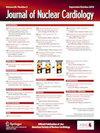在接受过同质化治疗的疑似心脏肉样瘤病患者队列中评估重复 PET 成像对治疗反应和心血管结果的影响。
IF 2.7
4区 医学
Q2 CARDIAC & CARDIOVASCULAR SYSTEMS
引用次数: 0
摘要
简介:对疑似心脏肉样瘤病(CS)患者进行连续 PET 成像检查是监测治疗反应的常规方法。皮质类固醇仍是治疗 CS 的主要手段。然而,目前还没有关于心血管后果和重复 PET 的最佳时间间隔的数据,同时也没有考虑到皮质类固醇减量对监测成像的影响:我们确定了81例疑似CS患者(年龄:56.3 ± 1.9,67%为男性,LVEF 46.5 ± 3),这些患者均未经治疗且基线PET显示有炎症,随后开始接受中等剂量泼尼松单药治疗(即30-40毫克/天),并进行了诊断性随访PET。治疗反应分为完全反应(CTR)、部分反应(PTR)和无反应(NTR)。根据 PET 扫描之间的随访时间将患者分为三等分;三等分-1(6.8 个月;中位数为 9.8 个月)。通过测量泼尼松从治疗开始到随访一年期间的每周变化情况来了解皮质类固醇的减量情况。主要心血管不良事件(MACE)定义为基线 PET 治疗后第一年内出现的持续性室性心律失常:不同分层的治疗反应 CTR/PTR/NTR 率相似:(1 层(92%) vs 2 层(86.2%) vs 3 层(85.2%);P=0.76)。三组的减量率和一年的泼尼松累积剂量相似(P=0.9)。三等分组之间的短期 MACE 无明显差异(P=0.89)。同样,根据治疗反应状态,MACE也无明显差异(P=0.39):结论:对于仅开始使用中等剂量泼尼松的患者,监视时间和减量率似乎并不影响 PET 扫描的治疗反应。尽管随访时间和治疗反应状态不同,但观察到的 MACE 发生率相似。本文章由计算机程序翻译,如有差异,请以英文原文为准。
Assessing the effect of repeat positron emission tomography imaging on treatment response and cardiovascular outcomes among a homogenously treated cohort of patients with suspected cardiac sarcoidosis
Background
Serial positron emission tomography (PET) imaging is routinely used to monitor treatment response in patients with suspected cardiac sarcoidosis (CS). Corticosteroids remain the mainstay of therapy in CS. However, there are no data available on the cardiovascular outcomes and optimal timing interval to obtain repeat PET while factoring in the influence of corticosteroid taper in relation to surveillance imaging.
Methods
We identified 81 patients with suspected CS (age: 56.3 ± 1.9, 67% male, left ventricle ejection fraction: 46.5 ± 3) who were not on immunosuppression treatment and demonstrated inflammation on baseline PET, subsequently started on moderate-dose prednisone monotherapy (i.e., 30-40 mg/day), and had a diagnostic follow-up PET. Treatment response was graded as complete treatment response (CTR) or partial treatment response (PTR) vs no response. Patients were divided into tertiles based on follow-up time between PET scans; tertile-1 (<3.2 months; median: 3.1 months), tertile-2 (3.2-6.8 months; median: 5.9 months), and tertile-3 (>6.8 months; median: 9.8 months). Corticosteroid taper was captured by measuring weekly changes in prednisone from the start of treatment to up to one-year follow-up. Major adverse cardiovascular events (MACEs), defined as sustained ventricular arrhythmias, were documented during the first year post baseline PET.
Results
Treatment response CTR/PTR rates were similar across tertiles: (tertile-1 [92%] vs tertile-2 [86.2%] vs tertile-3 [85.2%]; P = .76). Taper rates and one-year cumulative prednisone dose were similar between the three groups (P = .9). No significant difference was found in short-term MACEs between the tertile groups (P = .89). Similarly, MACEs did not differ significantly according to treatment response status (P = .39).
Conclusions
Surveillance time and taper rates do not seem to influence treatment response on PET scans among patients initiated on moderate-dose prednisone only. Similar MACE rates were observed despite variations in follow-up time and treatment response status.
求助全文
通过发布文献求助,成功后即可免费获取论文全文。
去求助
来源期刊
CiteScore
5.30
自引率
20.80%
发文量
249
审稿时长
4-8 weeks
期刊介绍:
Journal of Nuclear Cardiology is the only journal in the world devoted to this dynamic and growing subspecialty. Physicians and technologists value the Journal not only for its peer-reviewed articles, but also for its timely discussions about the current and future role of nuclear cardiology. Original articles address all aspects of nuclear cardiology, including interpretation, diagnosis, imaging equipment, and use of radiopharmaceuticals. As the official publication of the American Society of Nuclear Cardiology, the Journal also brings readers the latest information emerging from the Society''s task forces and publishes guidelines and position papers as they are adopted.

 求助内容:
求助内容: 应助结果提醒方式:
应助结果提醒方式:


